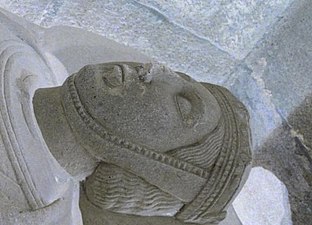Barbette (mode)
pièce de lin, portée au Moyen Âge, pour couvrir oreilles, cou et menton
La barbette est une légère pièce de lin, portée au Moyen Âge, généralement en même temps qu'un autre couvre-chef. Elle passait sous le menton et était fixée sur les côtés, pour couvrir les oreilles, le cou et parfois le menton, d'où son nom évoquant la barbe[1]. Elle fut principalement portée du XIIe siècle au XIVe siècle, plus rarement au début du XVe siècle.

Galerie
modifier- Le Codex Manesse, début du XIVe siècle
Bibliographie
modifier- Cumming, Valerie, C.W. Cunnington and P.E. Cunnington. The Dictionary of Fashion History. New York: Berg, 2010.
- Hill, Daniel Delis. History of World Costume and Fashion. Upper Saddle River, NJ: Pearson Prentice Hall, 2011. http://www.worldcat.org/oclc/939043732.
- Lewandowski, Elizabeth J. The Complete Costume Dictionary. Lanham, MD: Scarecrow Press, 2011. http://www.worldcat.org/oclc/694238143.
- Norris, Herbert. Medieval Costume and Fashion. New York: Dover Publications, 1999. http://www.worldcat.org/oclc/987785495.
- Tortora, Phyllis G., and Sara B. Marcketti. Survey of Historic Costume. Sixth edition. New York: Fairchild Books, 2015.
- Jan Seewald: Theatrical Sculpture – Skulptierte Bildnisse berühmter englischer Schauspieler, Herbert Utz Verlag, 2007, S. 147.
- 2. Die Barbe. In: Grammatisch-Kritisches Wörterbuch der Hochdeutschen Mundart. Leipzig, 1793–1801
Références
modifier- (de) Cet article est partiellement ou en totalité issu de l’article de Wikipédia en allemand intitulé « Barbette (Mode) » (voir la liste des auteurs).
- Fashion History Timelime (State University of New York), Barbette



